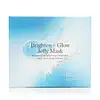What's inside
What's inside
 Key Ingredients
Key Ingredients

 Benefits
Benefits

 Concerns
Concerns

 Ingredients Side-by-side
Ingredients Side-by-side

Water
Skin ConditioningDipropylene Glycol
HumectantPEG-75
HumectantAlgin
MaskingGlycerin
HumectantButylene Glycol
HumectantSodium Chloride
MaskingTetrasodium Pyrophosphate
BufferingCellulose Gum
Emulsion Stabilising1,2-Hexanediol
Skin ConditioningHydroxyacetophenone
AntioxidantOctyldodeceth-16
EmulsifyingCaprylic/Capric Triglyceride
MaskingHydrolyzed Collagen
EmollientDisodium EDTA
Mentha Piperita Oil
MaskingPolyglyceryl-3 Methylglucose Distearate
EmulsifyingUltramarines
Centella Asiatica Extract
CleansingArtemisia Vulgaris Extract
Skin ConditioningAloe Barbadensis Leaf Extract
EmollientPearl Extract
AntioxidantSodium Hyaluronate
HumectantTranexamic Acid
AstringentTotarol
AntioxidantBetaine
HumectantPersea Gratissima Oil
Skin ConditioningAllantoin
Skin ConditioningOlea Europaea Fruit Oil
MaskingTrehalose
HumectantHelianthus Annuus Seed Oil
EmollientCI 42090
Cosmetic ColorantAluminum Hydroxide
EmollientCopper Tripeptide-1
Skin ConditioningAcetyl Hexapeptide-8
HumectantPalmitoyl Pentapeptide-4
Skin ConditioningPalmitoyl Tetrapeptide-7
Skin ConditioningPalmitoyl Tripeptide-1
Skin ConditioningGlucose
HumectantCI 77231
Cosmetic ColorantZea Mays Starch
AbsorbentMelaleuca Alternifolia Leaf Powder
AbrasiveNiacinamide
SmoothingAloe Barbadensis Leaf Juice Powder
Skin ConditioningPearl Powder
Euterpe Oleracea Pulp Powder
AbrasiveAdenosine
Skin ConditioningCentella Asiatica Leaf/Stem Powder
Potassium Alginate
Emulsion StabilisingWater, Dipropylene Glycol, PEG-75, Algin, Glycerin, Butylene Glycol, Sodium Chloride, Tetrasodium Pyrophosphate, Cellulose Gum, 1,2-Hexanediol, Hydroxyacetophenone, Octyldodeceth-16, Caprylic/Capric Triglyceride, Hydrolyzed Collagen, Disodium EDTA, Mentha Piperita Oil, Polyglyceryl-3 Methylglucose Distearate, Ultramarines, Centella Asiatica Extract, Artemisia Vulgaris Extract, Aloe Barbadensis Leaf Extract, Pearl Extract, Sodium Hyaluronate, Tranexamic Acid, Totarol, Betaine, Persea Gratissima Oil, Allantoin, Olea Europaea Fruit Oil, Trehalose, Helianthus Annuus Seed Oil, CI 42090, Aluminum Hydroxide, Copper Tripeptide-1, Acetyl Hexapeptide-8, Palmitoyl Pentapeptide-4, Palmitoyl Tetrapeptide-7, Palmitoyl Tripeptide-1, Glucose, CI 77231, Zea Mays Starch, Melaleuca Alternifolia Leaf Powder, Niacinamide, Aloe Barbadensis Leaf Juice Powder, Pearl Powder, Euterpe Oleracea Pulp Powder, Adenosine, Centella Asiatica Leaf/Stem Powder, Potassium Alginate
Water
Skin ConditioningPentylene Glycol
Skin ConditioningGlycerin
HumectantAlgin
MaskingLithium Magnesium Sodium Silicate
AbsorbentSodium Hyaluronate
HumectantOryza Sativa Powder
Xanthan Gum
EmulsifyingConchiolin Powder
AbrasiveSodium Hydroxide
BufferingCitric Acid
BufferingTetrasodium Glutamate Diacetate
Anthemis Nobilis Flower Oil
MaskingMentha Viridis Leaf Oil
AstringentBenzyl Alcohol
PerfumingDehydroacetic Acid
PreservativeCI 42090
Cosmetic ColorantGlucose
HumectantCI 77231
Cosmetic ColorantTetrasodium Pyrophosphate
BufferingMagnesium Oxide
AbsorbentWater, Pentylene Glycol, Glycerin, Algin, Lithium Magnesium Sodium Silicate, Sodium Hyaluronate, Oryza Sativa Powder, Xanthan Gum, Conchiolin Powder, Sodium Hydroxide, Citric Acid, Tetrasodium Glutamate Diacetate, Anthemis Nobilis Flower Oil, Mentha Viridis Leaf Oil, Benzyl Alcohol, Dehydroacetic Acid, CI 42090, Glucose, CI 77231, Tetrasodium Pyrophosphate, Magnesium Oxide
Ingredients Explained
These ingredients are found in both products.
Ingredients higher up in an ingredient list are typically present in a larger amount.
Algin is brown algae. Algae is an informal term for a group of aquatic organisms that can photosynthesize. It is estimated there are at least 30,000 types of Algae.
Algae contains antioxidants. Antioxidants help fight free-radicals. Free-radicals are molecules that may damage your skin cells, such as pollution.
Ci 42090 is a synthetic dye created from petroleum. It is used to give a bright blue color to cosmetics, medicine, and food.
We don't have a description for CI 77231 yet.
Glucose is a simple sugar and is the most important source of energy in all organisms.
In skincare, glucose is used to hydrate the skin. It also acts as a prebiotic for our natural biome.
Glucose is hydrating due to its humectant property. As a humectant, glucose draws moisture from the air and from deeper levels in the skin.
Our skin contains many sugars that act as prebiotics and help strengthen our natural microbiome. Having a healthy microbiome helps protect our skin from harmful bacteria and other contaminants.
Studies show glucose may help with fading discoloration and pigmentation. This is because our skin metabolizes glucose into lactic acid. Lactic acid is an AHA that helps exfoliate the top layer of skin.
Learn more about GlucoseGlycerin is already naturally found in your skin. It helps moisturize and protect your skin.
A study from 2016 found glycerin to be more effective as a humectant than AHAs and hyaluronic acid.
As a humectant, it helps the skin stay hydrated by pulling moisture to your skin. The low molecular weight of glycerin allows it to pull moisture into the deeper layers of your skin.
Hydrated skin improves your skin barrier; Your skin barrier helps protect against irritants and bacteria.
Glycerin has also been found to have antimicrobial and antiviral properties. Due to these properties, glycerin is often used in wound and burn treatments.
In cosmetics, glycerin is usually derived from plants such as soybean or palm. However, it can also be sourced from animals, such as tallow or animal fat.
This ingredient is organic, colorless, odorless, and non-toxic.
Glycerin is the name for this ingredient in American English. British English uses Glycerol/Glycerine.
Learn more about GlycerinSodium Hyaluronate is hyaluronic acid's salt form. It is commonly derived from the sodium salt of hyaluronic acid.
Like hyaluronic acid, it is great at holding water and acts as a humectant. This makes it a great skin hydrating ingredient.
Sodium Hyaluronate is naturally occurring in our bodies and is mostly found in eye fluid and joints.
These are some other common types of Hyaluronic Acid:
Learn more about Sodium HyaluronateWe don't have a description for Tetrasodium Pyrophosphate yet.
Water. It's the most common cosmetic ingredient of all. You'll usually see it at the top of ingredient lists, meaning that it makes up the largest part of the product.
So why is it so popular? Water most often acts as a solvent - this means that it helps dissolve other ingredients into the formulation.
You'll also recognize water as that liquid we all need to stay alive. If you see this, drink a glass of water. Stay hydrated!
Learn more about Water